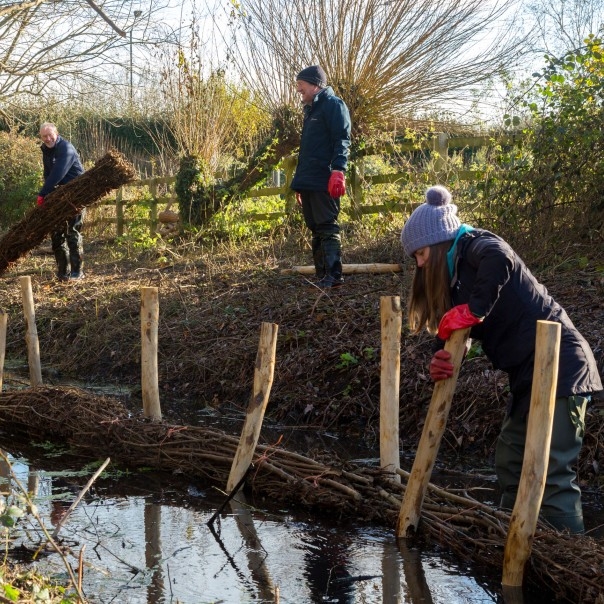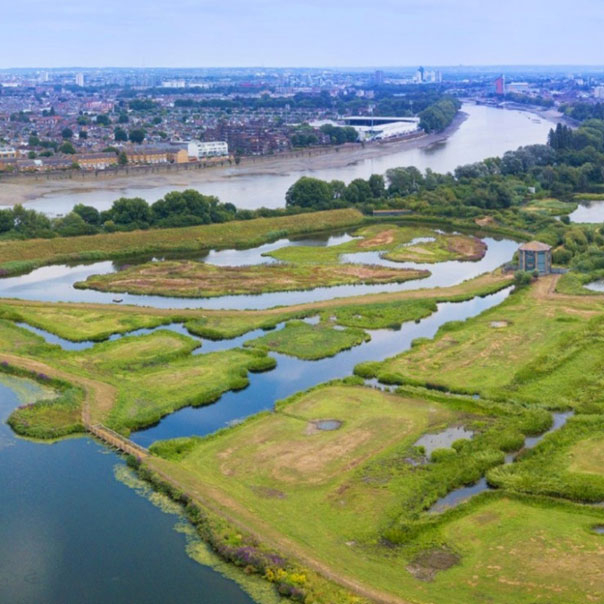SuDS for Schools
Climate change and population growth means that standard urban drains are overloaded, flooding homes and polluting rivers. A sustainable solution uses nature to prevent these problems and bring added benefits.
The challenge
For a long time we’ve treated rainwater as waste. Our towns and cities are engineered to quickly channel rain into traditional drains that take it to the surrounding streams. Towns have grown and rain falls more heavily and erratically, overloading the drains.
In some areas the drains then spill into the sewage system, releasing foul water into our rivers and even our homes, poisoning wildlife and ruining lives. Even in areas where rain and sewage are kept separate, rainwater washes chemical pollution from our streets into our water.
Why SuDS?
SuDS are sustainable drainage systems. They work on a different principle. They manage the rain at the point it hits the ground or roof, slow the flow of water and clean it up along the way.
They retain water in a system of ponds, swales, rain gardens and filter strips and can be created anywhere it rains! Much of the rainwater is then taken up by plants, percolates into the ground or evaporates into the air. What rainwater remains only reaches the drains slowly if at all. It is less polluted, and there is no sudden surge of water that overloads the system.
SuDS don’t just solve the drainage problem. They incorporate water and plants, so they can help wildlife in the same ways as natural wetlands. And a variety of SuDS across a neighbourhood works together as blue and green corridors, to help animals move between larger areas of urban habitat such as parks and nature reserves. SuDS can be large, such as floodwater storage lakes in parks or on housing estates. Here there’s the opportunity to create places for people to enjoy, that are a valuable resource for the community.
With careful planning there’s the potential to create networks of SuDS in our towns and cities that manage surface water and improve local water quality, while helping wildlife (and people) cope with urban living. Many local authorities already recognise that they can deliver many extra benefits to their community through SuDS for the same or less that it costs to build and maintain conventional drainage systems.
What we are doing
We built SuDS in ten schools in a North London catchment, at risk from surface water flooding. The SuDS mimicked the functions of natural wetlands to reduce localised flooding, create green and blue space, and improve water quality in streams. They also quickly became places where students played and learnt outdoors.
At the start of the project, 80% of students, staff and local people didn’t even know the name of their local river. But through parents and teachers and their networks in the local community, the schools became hubs for reconnecting the local people with their stream, the Pymmes Brook.
This is the first project to create SuDS in multiple schools in a single river catchment. It brought neighbourhood scale flood protection whilst delivering learning, awareness, skills development and enhanced green/blue infrastructure in the local community.
Co-design, delivery and management with local stakeholders were essential in creating a sustainable legacy helping to secure the future of the SuDS. Instead of thinking of rain as a waste product to be taken away as soon as possible, it’s now seen as a resource to be kept at the surface and enhance wildlife. This allowed us to create wetland oases to store surface water during cloudbursts and to make better places in which to live, work and play.
Successes so far
- Reduced peak flows to the Pymmes Brook in Enfield, thereby controlling erosion and flooding in stream through ten SuDS built in local schools
- Reduced pollution of stream from roads, car-parks and buildings
- Retention of rainfall within SuDS reducing risk of local surface water flooding
- Increased biodiversity in school grounds
- New opportunities for outdoor play and learning (one school only had tarmac for students to play in; now it has a wetland nature reserve!)
- Greater knowledge and awareness of the need for sustainable surface water management within the local community
- After construction, each school landscaped and planted their SuDS and received training in maintenance and habitat management
If you're a local authority, developer or just someone who wants to improve the way you manage water runoff, our guide to Sustainable Drainage Systems will take you step-by-step through the process.
Download the guide
